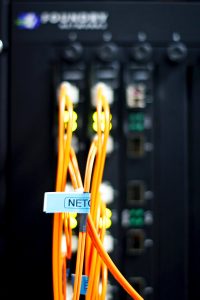
How to Determine if Fiber Optic Cable Is Best Suited for Your Installation

Fiber optics offer several advantages over copper conduction. From computer networks to telecommunications, the superior properties of fiber optics make it a staple in many applications. But how do you tell if it is the best choice for your installation? In this article, we discuss fiber optic cables and their benefits.
From telecommunication and computer networking to health care and defense, fiber optics has revolutionized the way many sectors perform their tasks. It offers multiple advantages over electrical signal transmission but choosing which one for your application requires an understanding of its properties.
Remee will highlight exactly what you need to know about fiber optics, why it’s important, and how you can use fiber optic cabling. Read on to see where fiber optics can shine brightest for your custom fiber optic cable needs!
What Are Fiber Optics?
 Fiber optics… such a familiar name, but have you ever stopped for a second and wondered what are fiber optic cables made of? Look out your window, and you’ll see it! In the early 1960s, Charles Kao’s research on the physical properties of glass laid the foundation for modern-day fiber optics technology. For years, glass was considered unusable due to the fact that when the light hit, it scattered, resulting in severe signal loss.
Fiber optics… such a familiar name, but have you ever stopped for a second and wondered what are fiber optic cables made of? Look out your window, and you’ll see it! In the early 1960s, Charles Kao’s research on the physical properties of glass laid the foundation for modern-day fiber optics technology. For years, glass was considered unusable due to the fact that when the light hit, it scattered, resulting in severe signal loss.
Kao’s research allowed him to discover that highly purified, thin strands of glass fibers could be used to carry light signals. “Fiber optics” refers simply to the transmission of light through thin glass filaments known as optical fibers. Once they’re twisted into bundles to form an optical fiber cable, fiber optic technology can be used to convey light from one point to another.
The field of fiber optics was born soon after that, and many industries have greatly benefited from its advancements. Considering the need for custom fiber optic cables? Reach out to Remee to request a quote or custom fiber optic cable that suits your installation needs.
Maximize Performance With Custom Fiber Optic Cables
While fiber optic cables could now carry a signal, Kao’s discovery also found that fiber optic cables could actually transmit data farther and faster than the industry standard with conventional copper. Since these fiber optic cables are flexible and reflect the photons that bounce back and forth within them efficiently, they’re ideal for transmitting light signals over long distances with minimal loss.
Now that you know the history of fiber optics, understanding the properties of fiber optic cables can help you decide if it’s the best cable option for you. Some of the most beneficial fiber optics properties include better:
- Signals
- Bandwidth
- Speed
- Distance
Another benefit of fiber optics is its superior safety. Optical fiber cabling conducts light rather than electricity, which means it’s unable to generate a spark. That makes it a better choice in chemically volatile environments or other applications where safety is a chief concern.
Industries that Benefit from Fiber Optic Cables
 With so many benefits to offer, fiber optic technology is employed for many different applications among many different industries. How wild to think that such tiny fiber optic cables enable a world of communication and data!
With so many benefits to offer, fiber optic technology is employed for many different applications among many different industries. How wild to think that such tiny fiber optic cables enable a world of communication and data!
Fiber optics touches everyone’s lives in some way, shape, or form. The most common industries and places you can find fiber optics at work include:
- Telecommunications sector – transmit signals to buildings, towers, and antennas to increase communication and safety
- Healthcare sector – clearer microscopy, better medical imaging, and more efficient medical devices, such as optical surgical assemblies
- Military – development of progressive weapons and safety technology
- Data centers – an environment that supports hyperscale computing using fiber
- Internet – connects users to the IoT
Fiber optic technology is also being implemented to design the fiber optic trends of the future. You can begin to see this already with automation in the industrial and automotive sectors. Autonomous vehicles will need to transmit data in near-real time to make the correct driving decisions. You can expect fiber to be used in your car for a lot more than lighting.
As smart cities continuously evolve, wireless IoT devices that rely on the high transmission capacity of 5G must eventually link to a wired network, and optical fibers will be the chief means of carrying so much data. As the internet of things (IoT) continues to grow, fiber optic cable will continue to foster future industrial growth.
Fiber Optic Cable Types that Remee Supplies
 As a leading wire and cable manufacturer, Remee has one of the largest selections of fiber optic cable types. Over the years, fiber optic cables have grown in popularity and usage. Remee has also innovated and engineered designs to make sure we have every fiber optic cable you need.
As a leading wire and cable manufacturer, Remee has one of the largest selections of fiber optic cable types. Over the years, fiber optic cables have grown in popularity and usage. Remee has also innovated and engineered designs to make sure we have every fiber optic cable you need.
Our fiber optic cable selection includes:
- Loose Tube
- RemCoreTM – MicroTube cables
- Tight Buffered
- General Purpose
- Distribution
- Breakout cable
- Single Mode
- Multimode
- Simplex
- Duplex
- Indoor & outdoor fiber optic cable
Remee can also modify standard fiber optic cables, such as incorporating:
- Armored & unarmored configurations
- Polyethylene, Low Smoke Zero Halogen & PVC jacket types
- 2 – 288 fibers
- Single mode, Multimode, OM3 & OM4 configurations
- 10 GIG fiber types
- AquaLock® dry tube technology for loose tube fiber
- Standard gel-filled options
- Plenum fiber optic cable
Remee offers a specialized “Cut-to-Order” program. This allows our standard fiber optic cables to be cut at custom lengths, and shipped out within 24-48 hours, allowing convenience, efficiency, and decreased costs for our customers. See how our Cut-to-Order program can help you save time and money today!
Why Choose Plenum Fiber Optic Cable
As you can see in the list above, one of the fiber optic cable options offered by Remee is Plenum Fiber Optic Cable. This type of fiber optic cable utilizes a special type of insulation that gives the cable lower smoke and flame characteristics.
While fiber optic cable does not pose a fire risk, fires can happen in cables near it or in the general vicinity, and plenum fiber optic cable helps lower the risk of danger if these cables are exposed to fire.
When it comes to fire, the use of plenum fiber optic cable can help prevent injury, loss of profit, and wasted product.
On the copper side, Remee’s Vigilance™ Standard Plenum-rated Fire Alarm Cables and Vigilance™ Plenum-rated Security Cables can help decrease your chances of fire-related cable issues.
Remee Supplies Your Optical Fiber Cabling Needs
Whether it’s the high-speed transmission, clearer signal, improved safety, or more secure connection, the benefits that fiber optics bring to the table have made it a bright idea for engineers to implement in a wide number of fields and applications.
Remee is an industry leader in fiber optic cable, so we have both the expertise and the facilities to manufacture the design that best suits your application. With our experience, we’ve been able to compile an amazing selection of standard, modified standard, and custom fiber optics cables.
Supported by our commitment to personalized service, Remee is fully prepared to help with any detail of your custom optical fiber cable project – or non-fiber optic cable project! With a world-class integrated supply chain and the location of our manufacturing operations right here in America, we ensure our ability to safely deliver the cable assembly you need.
Connect with us today, and take your cable installation to the next level with Remee’s leading fiber optic cable solutions.
Sign Up for Our Semi-monthly E-Newsletter!
